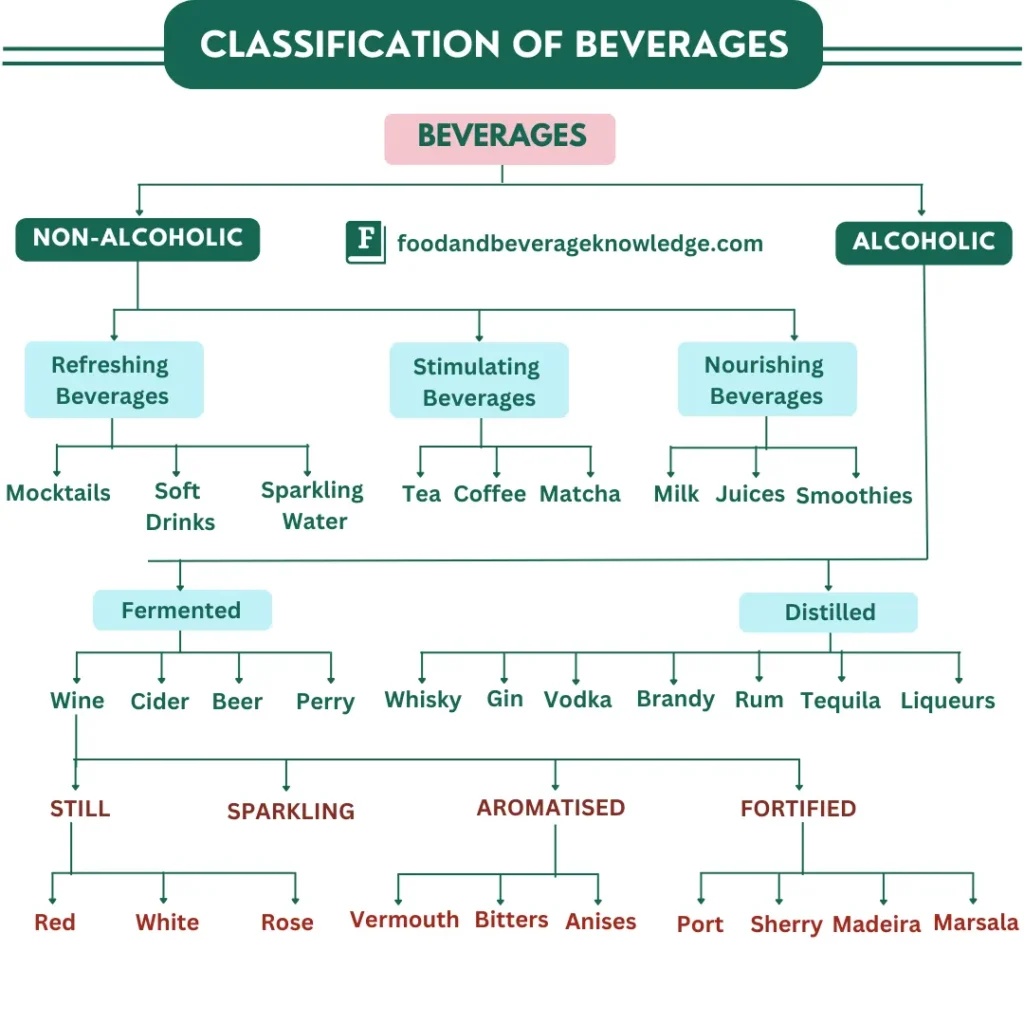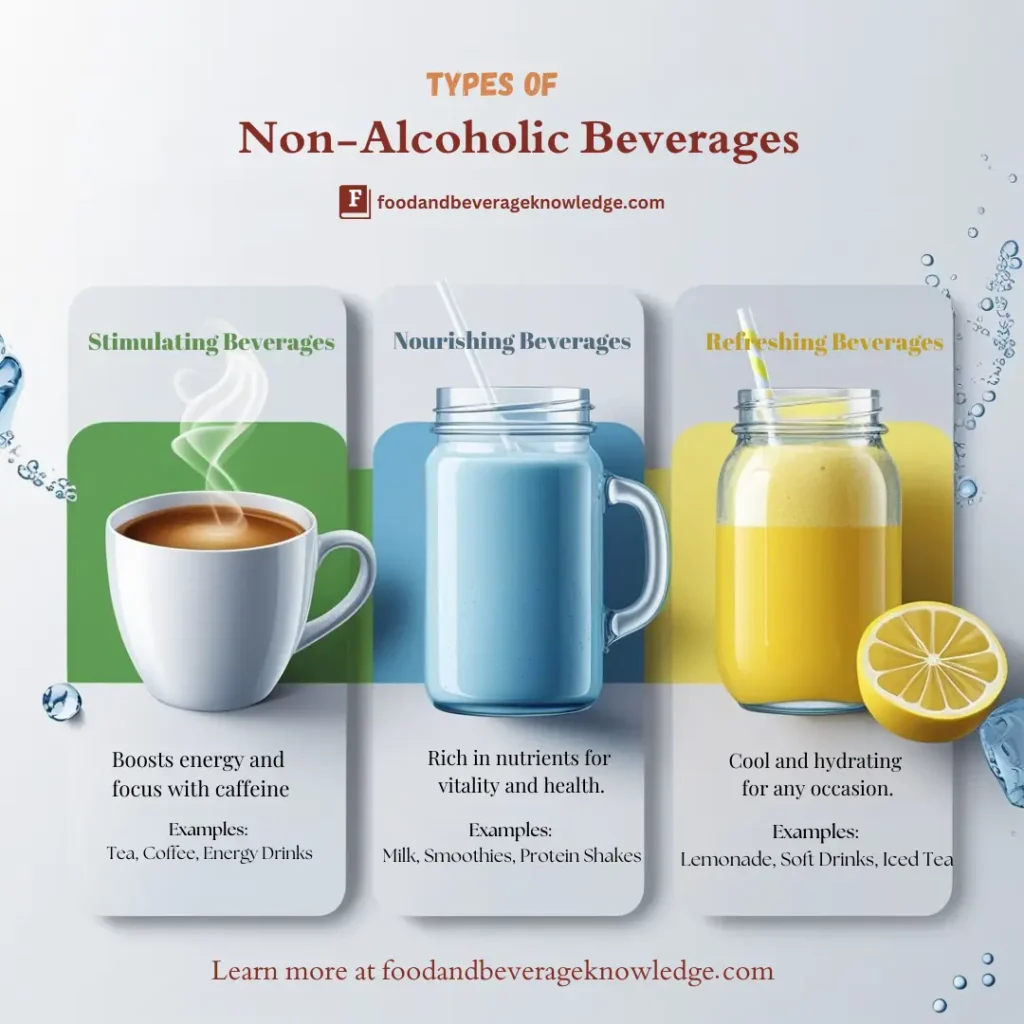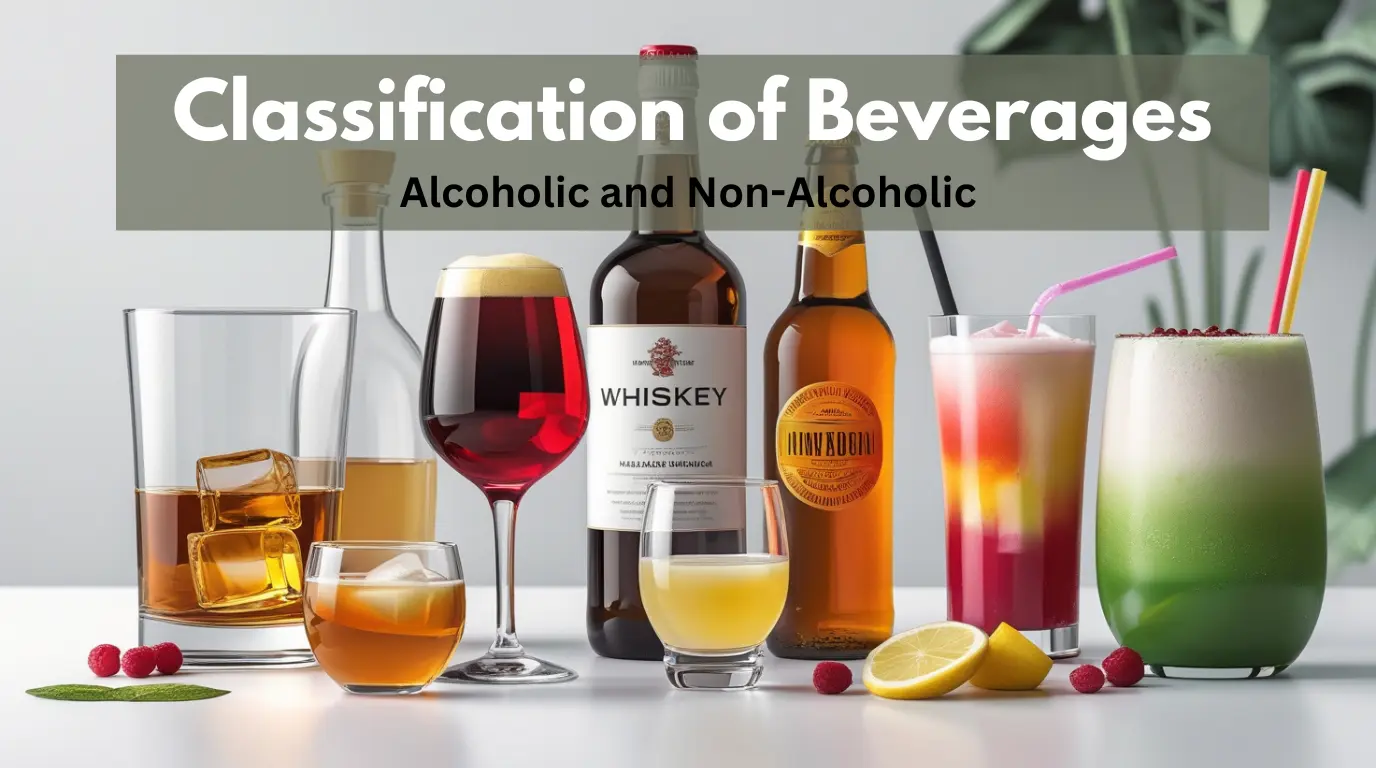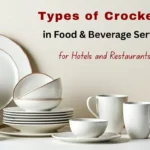Beverages have been an integral part of human culture for centuries, offering not just hydration but also pleasure, indulgence, and even cultural significance. From the humble cup of tea to the elaborate cocktail creations, the world of beverages is vast and diverse.
This guide will take you through the classification of beverages and their various types, covering both alcoholic and non-alcoholic drinks in detail.
What Is a Beverage?
A beverage is any potable liquid intended for human consumption other than water. Beverages serve more than the basic function of satisfying thirst; they are often associated with social and cultural rituals, celebrations, and personal preferences. The word “beverage” comes from the Latin word bever, which means to drink.
Before diving into the main content, check out this infographic showcasing the classification of beverages into alcoholic and non-alcoholic, along with examples.

Classification of Beverages
Beverages can be classified broadly into two categories:
- Alcoholic Beverages
- Non-Alcoholic Beverages
Each category further branches into subcategories based on preparation methods, ingredients, and intended use.
1. Alcoholic Beverages
Alcoholic beverages contain ethanol (alcohol) produced through fermentation or distillation. These beverages have been consumed since prehistoric times for relaxation, celebration, and even medicinal purposes.
These drinks are categorised into two main types: fermented and distilled beverages.

Types of Alcoholic Beverages
A. Fermented Alcoholic Beverages
Fermented alcoholic beverages are created through the natural process of fermentation, during which yeasts convert sugars into alcohol and carbon dioxide. This category includes a variety of drinks that differ in flavour, texture, and alcohol content. These include:
Wine: Made from the fermentation of grapes or other fruits, wine is one of the oldest and most diverse alcoholic beverages. Its types include:
- Red Wine: Bold flavours and deep red hues; key varieties include Cabernet Sauvignon, Merlot, and Pinot Noir.
- White Wine: Light and refreshing; notable examples are Chardonnay, Sauvignon Blanc, and Riesling.
- Rosé Wine: Signature pink hue blending characteristics of red and white wines.
- Sparkling Wine: Effervescent varieties like Champagne, Prosecco, and Cava.
- Dessert Wine: Sweet wines such as Port (Portugal) and Sherry (Spain).
Want to learn about wine and cheese pairing? Read our guide on: 19 Popular Wine and Cheese Pairings: Matching Reds, Whites, and More
Beer: Brewed from malted grains, hops, water, and yeast. Popular varieties include:
- Ales: Robust and complex, e.g., Pale Ale and Brown Ale.
- Lagers: Crisp and refreshing, e.g., Pilsners.
- Stouts and Porters: Dark beers with flavours of coffee and chocolate.
- India Pale Ales (IPAs): Strong hop flavours.
Read more on beer: What are the different types of beer?
Cider: Fermented apple juice, ranging from sweet to dry.
Perry: Similar to cider but made from pears.
Read more about the fermentation process. Read our guide on: How Beer is Made: A Detailed Step-by-Step Guide
B. Distilled Alcoholic Beverages
Distilled beverages are made by distilling fermented liquids to increase their alcohol content, resulting in stronger spirits. These beverages are known for their unique flavours and higher alcohol content. Common examples include:
- Whiskey: Distilled from grain mash and aged in barrels. Types include Scotch, Bourbon, and Irish Whiskey.
- Vodka: Neutral spirit often made from grains or potatoes.
- Rum: Derived from sugarcane byproducts; includes White, Dark, and Spiced Rums.
- Gin: Flavoured with juniper berries and botanicals.
- Brandy: Distilled from wine or fermented fruit juices; includes Cognac and Armagnac.
- Tequila: Made from the blue agave plant; types include Blanco, Reposado, and Añejo.
- Liqueurs: Sweetened spirits infused with flavours, e.g., Amaretto, Baileys, and Grand Marnier.
- Mead: Made from fermented honey, often mixed with fruits or spices.
2. Non-Alcoholic Beverages
Non-alcoholic beverages do not contain significant alcohol content and are often consumed for hydration, energy, or enjoyment. These are further classified into stimulating, nourishing, and refreshing beverages.

Types of Non-Alcoholic Beverages
A. Stimulating Beverages
These beverages contain caffeine or other stimulants that enhance alertness and energy levels:
- Tea: Includes Black, Green, Oolong, and Herbal varieties.
- Coffee: Brewed from roasted coffee beans; types include espresso, lattes, cappuccino, and cold brew.
- Energy Drinks: Contain caffeine and vitamins for an energy boost.
- Matcha: Ground green tea leaves offering antioxidants and caffeine.
B. Nourishing Beverages
Nourishing beverages provide essential nutrients:
- Milk: Includes dairy and plant-based options like almond and soy milk.
- Juices: Extracted from fruits or vegetables, e.g., orange and carrot juice.
- Smoothies: Blended drinks of fruits, vegetables, and yoghurt.
- Protein Shakes: Combine protein powders with milk or water.
C. Refreshing Beverages
These beverages are consumed for their cooling and hydrating effects:
- Soft Drinks: Carbonated and flavoured beverages.
- Mocktails: Non-alcoholic cocktails made with juices and syrups.
- Iced Teas and Coffees: Cold versions of traditional beverages.
- Lemonades and Flavoured Waters: Infused with fruits or herbs.
- Coconut Water: A Natural beverage rich in electrolytes.
- Sparkling Water: Carbonated water with or without flavours.
Also read: The Ultimate Guide to Wine Types: Exploring Varieties, Styles, and Characteristics
FAQS of Classification of Beverages
What are the main types of alcoholic beverages?
Alcoholic beverages include beer, wine, spirits (whiskey, vodka, rum), and cocktails. Each has a distinct flavour profile and alcohol content. The preparation and ingredients vary across cultures.
What are non-alcoholic beverages?
Non-alcoholic beverages include tea, coffee, fruit juices, smoothies, and mocktails. These drinks provide variety and hydration without any alcohol, making them popular choices for all ages.
What are the health benefits of non-alcoholic drinks?
Non-alcoholic drinks offer hydration, antioxidants, and vitamins. For instance, herbal teas can improve digestion, while smoothies can provide essential nutrients and energy.
What is the difference between beer and wine?
Beer is brewed from grains like barley and hops, while wine is made from fermented grapes. Both beverages undergo different fermentation processes and have unique taste profiles.
Conclusion
The classification and types of beverages reveal a fascinating diversity that caters to human needs, tastes, and cultures. Understanding these distinctions enriches our appreciation for what we drink and encourages informed choices.
From traditional tea ceremonies to the innovative craft beverage industry, the world of drinks is ever-evolving and deeply intertwined with human history.
Also Read
- The Ultimate Guide to Draft & Draught Beer: Everything You Need to Know
- Wine Service Procedure: How to Serve Red, White, and Champagne Like a Professional
- 7 different types of gin with brands name
Subscribe and join our community of hospitality professionals & students — get insights, tips, and the latest updates delivered straight to your inbox!







